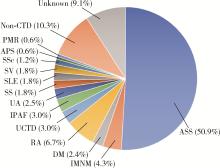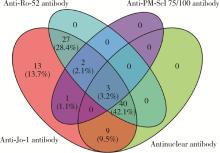Journal of Peking University (Health Sciences) ›› 2023, Vol. 55 ›› Issue (6): 958-965. doi: 10.19723/j.issn.1671-167X.2023.06.002
Previous Articles Next Articles
Significance of anti-Jo-1 antibody's clinical stratification in idiopathic inflammatory myopathy and disease spectrum
Jia-chen LI1,Zhan-hong LAI1,Miao SHAO1,Yue-bo JIN1,Xiao-juan GAO2,Ke ZHANG3,Jing HOU4,Yan-ying ZHANG5,Zhan-guo LI1,*( ),Yu-hui LI1,*(
),Yu-hui LI1,*( )
)
- 1. Department of Rheumatology and Immunology, Peking University People's Hospital, Beijing 100044, China
2. Department of Rheumatology and Immunology, Ningde Hospital Affiliated to Ningde Normal University, Ningde 352199, Fujian, China
3. Department of Endocrinology, 80th Group Army Hospital of Chinese PLA, Weifang 261000, Shandong, China
4. Department of Nephrology, Zhangjiakou First Hospital, Zhangjiakou 075041, Hebei, China
5. Department of Rheumatology, Shenzhen Hospital of Traditional Chinese Medicine, Shenzhen 518033, China
CLC Number:
- R593.2
| 1 |
Tanboon J , Nishino I . Classification of idiopathic inflammatory myopathies: Pathology perspectives[J]. Curr Opin Neurol, 2019, 32 (5): 704- 714.
doi: 10.1097/WCO.0000000000000740 |
| 2 |
Galindo-Feria AS , Horuluoglu B , Lundberg IE . Anti-Jo 1 autoantibodies, from clinic to the bench[J]. Rheumatology and Autoimmnity, 2022, 2 (2): 57- 68.
doi: 10.1002/rai2.12035 |
| 3 | García-De La Torre I . Clinical usefulness of autoantibodies in idiopathic inflammatory myositis[J]. Front Immunol, 2015, 6, 331. |
| 4 |
Ceribelli A , De Santis M , Isailovic N , et al. The immune response and the pathogenesis of idiopathic inflammatory myositis: A critical review[J]. Clin Rev Allergy Immunol, 2017, 52 (1): 58- 70.
doi: 10.1007/s12016-016-8527-x |
| 5 |
Zhan X , Yan W , Wang Y , et al. Clinical features of anti-synthetase syndrome associated interstitial lung disease: A retrospective cohort in China[J]. BMC Pulm Med, 2021, 21 (1): 57.
doi: 10.1186/s12890-021-01399-5 |
| 6 |
Fredi M , Cavazzana I , Quinzanini M , et al. Rare autoantibodies to cellular antigens in systemic lupus erythematosus[J]. Lupus, 2014, 23 (7): 672- 677.
doi: 10.1177/0961203314524850 |
| 7 |
Kumar RR , Jha S , Dhooria A , et al. Anti-Jo-1 syndrome often misdiagnosed as rheumatoid arthritis (for many years): A single-center experience[J]. J Clin Rheumatol, 2021, 27 (4): 150- 155.
doi: 10.1097/RHU.0000000000001234 |
| 8 |
Ishikawa Y , Yukawa N , Ohmura K , et al. Etanercept-induced anti-Jo-1-antibody-positive polymyositis in a patient with rheumatoid arthritis: A case report and review of the literature[J]. Clin Rheumatol, 2010, 29 (5): 563- 566.
doi: 10.1007/s10067-009-1370-1 |
| 9 |
Eriksson C , Rantapää-Dahlqvist S . Cytokines in relation to autoantibodies before onset of symptoms for systemic lupus erythematosus[J]. Lupus, 2014, 23 (7): 691- 696.
doi: 10.1177/0961203314523869 |
| 10 | 赵娜, 刘颖, 孙小凤, 等. 不同抗氨酰tRNA合成酶抗体阳性的抗合成酶综合征60例临床和影像学相关特征分析[J]. 中华风湿病学杂志, 2019, 23 (5): 320- 325. |
| 11 |
Adams RA , Fernandes-Cerqueira C , Notarnicola A , et al. Serum-circulating His-tRNA synthetase inhibits organ-targeted immune responses[J]. Cell Mol Immunol, 2021, 18 (6): 1463- 1475.
doi: 10.1038/s41423-019-0331-0 |
| 12 |
Honda M , Shimizu F , Sato R , et al. Jo-1 antibodies from myositis induce complement-dependent cytotoxicity and TREM-1 upregulation in muscle endothelial cells[J]. Neurol Neuroimmunol Neuroinflamm, 2023, 10 (4): e200116.
doi: 10.1212/NXI.0000000000200116 |
| 13 |
Cavagna L , Nuño L , Scirè CA , et al. Clinical spectrum time course in anti Jo-1 positive antisynthetase syndrome: Results from an international retrospective multicenter study[J]. Medicine (Baltimore), 2015, 94 (32): e1144.
doi: 10.1097/MD.0000000000001144 |
| 14 |
Monti S , Montecucco C , Cavagna L . Clinical spectrum of anti-Jo-1-associated disease[J]. Curr Opin Rheumatol, 2017, 29 (6): 612- 617.
doi: 10.1097/BOR.0000000000000434 |
| 15 |
Lundberg IE , Tjärnlund A , Bottai M , et al. 2017 European League Against Rheumatism/American College of Rheumatology classification criteria for adult and juvenile idiopathic inflammatory myopathies and their major subgroups[J]. Ann Rheum Dis, 2017, 76 (12): 1955- 1964.
doi: 10.1136/annrheumdis-2017-211468 |
| 16 |
Solomon J , Swigris JJ , Brown KK . Myositis-related interstitial lung disease and antisynthetase syndrome[J]. J Bras Pneumol, 2011, 37 (1): 100- 109.
doi: 10.1590/S1806-37132011000100015 |
| 17 |
Allenbach Y , Mammen AL , Benveniste O , et al. 224th ENMC international workshop: Clinico-sero-pathological classification of immune-mediated necrotizing myopathies Zandvoort, The Netherlands, 14-16 October 2016[J]. Neuromuscul Disord, 2018, 28 (1): 87- 99.
doi: 10.1016/j.nmd.2017.09.016 |
| 18 |
Mielnik P , Wiesik-Szewczyk E , Olesinska M , et al. Clinical features and prognosis of patients with idiopathic inflammatory myo-pathies and anti-Jo-1 antibodies[J]. Autoimmunity, 2006, 39 (3): 243- 247.
doi: 10.1080/08916930600623767 |
| 19 |
Aggarwal R , Cassidy E , Fertig N , et al. Patients with non-Jo-1 anti-tRNA-synthetase autoantibodies have worse survival than Jo-1 positive patients[J]. Ann Rheum Dis, 2014, 73 (1): 227- 232.
doi: 10.1136/annrheumdis-2012-201800 |
| 20 |
Ge YP , Zhang YL , Shu XM , et al. Clinical characteristics of anti-isoleucyl-tRNA synthetase antibody associated syndrome and comparison with different patient cohorts[J]. Clin Exp Rheumatol, 2022, 40 (3): 625- 630.
doi: 10.55563/clinexprheumatol/v2rbd0 |
| 21 |
Satoh M , Tanaka S , Ceribelli A , et al. A comprehensive overview on myositis-specific antibodies: New and old biomarkers in idiopathic inflammatory myopathy[J]. Clin Rev Allergy Immunol, 2017, 52 (1): 1- 19.
doi: 10.1007/s12016-015-8510-y |
| 22 |
Liu Y , Luo H , Wang L , et al. Increased serum matrix metalloproteinase-9 levels are associated with anti-Jo1 but not anti-MDA5 in myositis patients[J]. Aging Dis, 2019, 10 (4): 746- 755.
doi: 10.14336/AD.2018.1120 |
| 23 |
Zhao L , Su K , Liu T , et al. Myositis-specific autoantibodies in adults with idiopathic inflammatory myopathy: Correlations with diagnosis and disease activity[J]. Clin Rheumatol, 2021, 40 (3): 1009- 1016.
doi: 10.1007/s10067-020-05273-3 |
| 24 |
Zhang S , Shu X , Tian X , et al. Enhanced formation and impaired degradation of neutrophil extracellular traps in dermatomyositis and polymyositis: A potential contributor to interstitial lung disease complications[J]. Clin Exp Immunol, 2014, 177 (1): 134- 141.
doi: 10.1111/cei.12319 |
| 25 |
Kryštůfková O , Hulejová H , Mann HF , et al. Serum levels of B-cell activating factor of the TNF family (BAFF) correlate with anti-Jo-1 autoantibodies levels and disease activity in patients with anti-Jo-1positive polymyositis and dermatomyositis[J]. Arthritis Res Ther, 2018, 20 (1): 158.
doi: 10.1186/s13075-018-1650-8 |
| 26 |
Ascherman DP , Oriss TB , Oddis CV , et al. Critical requirement for professional APCs in eliciting T cell responses to novel fragments of histidyl-tRNA synthetase (Jo-1) in Jo-1 antibody-positive polymyositis[J]. J Immunol, 2002, 169 (12): 7127- 7134.
doi: 10.4049/jimmunol.169.12.7127 |
| 27 |
Oldroyd AGS , Allard AB , Callen JP , et al. A systematic review and meta-analysis to inform cancer screening guidelines in idiopathic inflammatory myopathies[J]. Rheumatology (Oxford), 2021, 60 (6): 2615- 2628.
doi: 10.1093/rheumatology/keab166 |
| 28 | 郑艺明, 郝洪军, 刘怡琳, 等. Ro52抗体与其他肌炎抗体共阳性的相关性研究[J]. 北京大学学报(医学版), 2020, 52 (6): 1088- 1092. |
| 29 |
Marie I , Hatron PY , Dominique S , et al. Short-term and long-term outcome of anti-Jo1-positive patients with anti-Ro52 antibody[J]. Semin Arthritis Rheum, 2012, 41 (6): 890- 899.
doi: 10.1016/j.semarthrit.2011.09.008 |
| [1] | Fang-ning YOU,Liang LUO,Xiang-jun LIU,Xue-wu ZHANG,Chun LI. Analysis of pregnancy outcomes, disease progression, and risk factors in patients with undifferentiated connective tissue disease [J]. Journal of Peking University (Health Sciences), 2023, 55(6): 1045-1052. |
| [2] | LUO Lan,XING Xiao-yan,XIAO Yun-shu,CHEN Ke-yan,ZHU Feng-yun-zhi,ZHANG Xue-wu,LI Yu-hui. Clinical and immunological characteristics of patients with anti-synthetase syndrome complicated with cardiac involvement [J]. Journal of Peking University (Health Sciences), 2021, 53(6): 1078-1082. |
| [3] | Shi-xiong WEI,Shu-jia LI,Yi LIU. Clinical characteristics and biological treatment of adult patient with juvenile idiopathic arthritis [J]. Journal of Peking University (Health Sciences), 2020, 52(6): 1014-1022. |
| [4] | Hai-hong YAO,Yi-ni WANG,Xia ZHANG,Jin-xia ZHAO,Yuan JIA,Zhao WANG,Zhan-guo LI. Clinical characteristics and treatment outcomes of macrophage activation syndrome in adults: A case series of 67 patients [J]. Journal of Peking University(Health Sciences), 2019, 51(6): 996-1002. |
|
||





